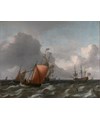description
Against the backdrop of a grey sky with towering cumulus clouds various ships are labouring in choppy waters. Although this view may not be topographically realistic it is conceivable the artist depicted an anchorage behind the Wadden Islands.1 The clientele of marine scenes generally put a premium on verisimilitude in the broadest sense. The coastal land on the right might therefore be one of the islands, which would explain the presence of buoys such as the one carrying the signature in the lower right foreground. The two gaff-rigged vessels in the foreground are a smalschip or wijdschip and behind it a kaag. These ships were used to transport cargo from bigger vessels to the shore and to help lift the anchors of large three-masters. Such a large ship, probably a warship, emerges behind the wijdschip starboard bow view with the wind on the starboard quarter. Her sails are adjusted to maneuver in a stiff breeze. The two other three-masters at anchor in the distance are merchantmen, the one in the right background a pinas and the other further away a fluitschip. The two smaller vessels in the far distance are probably herring busses while another wijdschip can be discerned in the left distance.
Aernout Smit was an accomplished marine specialist who took his inspiration from Ludolf Bakhuizen (1630-1708) and his teacher Jan Teunisz Blanckerhoff (1628-69).2 His paintings have often been mistaken for works by these artists. Smit is also known to have copied works by Bakhuizen.3 Smit was prolific and his preserved output spans a wide range of marine subjects. He depicted seas as well as inland waters and his paintings show a rich variety of shipping in different weather conditions. His stormy seas with sweeping clouds are spectacular. In his calms with their silvery tonality Smit strikes a completely different mood. Smit only very rarely dated his paintings.
The earliest documentary information on Aernout Smit is the registration of his wedding banns in Amsterdam’s town hall on 1 September 1663, on which occasion he states he is a seaman from Nieuwpoort and living on Prinsengracht.4 Smit married Marretje Jans, and the newly-weds may have been catholic. It was the biographer of artists Arnold Houbraken (1660-1719) who wrote that Smit was a pupil of Blanckerhoff, which is quite plausible. It is likely that Smit trained with the latter during the late 1650s after having worked as seaman as a bachelor. The earliest instance when Smit is referred to as a painter is in 1667. At this point Smit was engaged by an art dealer to paint in an attic, a not uncommon arrangement for young artists who are not yet able to set up a career independently. Smit’s earliest dated work is from 1667. Later in his career, Smit seems to have fared well and he is documented as a member of the Amsterdam guild of Saint Luke, but his last years were probably been spent in financial difficulty, as suggested by the tax register of marriages and funerals which shows that no tax was paid on his wealth after his death. One prestigious commission was granted him in 1691 to paint a series of ship portraits for the country manor of Lieutenant-Admiral Cornelis Tromp (1629-91), Trompenburg in ‘s Graveland.
Aernout Smit was an accomplished marine specialist who took his inspiration from Ludolf Bakhuizen (1630-1708) and his teacher Jan Teunisz Blanckerhoff (1628-69).2 His paintings have often been mistaken for works by these artists. Smit is also known to have copied works by Bakhuizen.3 Smit was prolific and his preserved output spans a wide range of marine subjects. He depicted seas as well as inland waters and his paintings show a rich variety of shipping in different weather conditions. His stormy seas with sweeping clouds are spectacular. In his calms with their silvery tonality Smit strikes a completely different mood. Smit only very rarely dated his paintings.
The earliest documentary information on Aernout Smit is the registration of his wedding banns in Amsterdam’s town hall on 1 September 1663, on which occasion he states he is a seaman from Nieuwpoort and living on Prinsengracht.4 Smit married Marretje Jans, and the newly-weds may have been catholic. It was the biographer of artists Arnold Houbraken (1660-1719) who wrote that Smit was a pupil of Blanckerhoff, which is quite plausible. It is likely that Smit trained with the latter during the late 1650s after having worked as seaman as a bachelor. The earliest instance when Smit is referred to as a painter is in 1667. At this point Smit was engaged by an art dealer to paint in an attic, a not uncommon arrangement for young artists who are not yet able to set up a career independently. Smit’s earliest dated work is from 1667. Later in his career, Smit seems to have fared well and he is documented as a member of the Amsterdam guild of Saint Luke, but his last years were probably been spent in financial difficulty, as suggested by the tax register of marriages and funerals which shows that no tax was paid on his wealth after his death. One prestigious commission was granted him in 1691 to paint a series of ship portraits for the country manor of Lieutenant-Admiral Cornelis Tromp (1629-91), Trompenburg in ‘s Graveland.
Aernout Smit (Nieuwpoort 1640 - Amsterdam 1710)
Dutch Three-Masters and Other Shipping
Signed lower right, on the buoy:
A. SMIT
Contact
Bijl-van Urk Masterpaintings
Alkmaar


